Ali Mousavi
From Keypoints to Realism: A Realistic and Accurate Virtual Try-on Network from 2D Images
Apr 04, 2025Abstract:The aim of image-based virtual try-on is to generate realistic images of individuals wearing target garments, ensuring that the pose, body shape and characteristics of the target garment are accurately preserved. Existing methods often fail to reproduce the fine details of target garments effectively and lack generalizability to new scenarios. In the proposed method, the person's initial garment is completely removed. Subsequently, a precise warping is performed using the predicted keypoints to fully align the target garment with the body structure and pose of the individual. Based on the warped garment, a body segmentation map is more accurately predicted. Then, using an alignment-aware segment normalization, the misaligned areas between the warped garment and the predicted garment region in the segmentation map are removed. Finally, the generator produces the final image with high visual quality, reconstructing the precise characteristics of the target garment, including its overall shape and texture. This approach emphasizes preserving garment characteristics and improving adaptability to various poses, providing better generalization for diverse applications.
Phi-4-Mini Technical Report: Compact yet Powerful Multimodal Language Models via Mixture-of-LoRAs
Mar 03, 2025Abstract:We introduce Phi-4-Mini and Phi-4-Multimodal, compact yet highly capable language and multimodal models. Phi-4-Mini is a 3.8-billion-parameter language model trained on high-quality web and synthetic data, significantly outperforming recent open-source models of similar size and matching the performance of models twice its size on math and coding tasks requiring complex reasoning. This achievement is driven by a carefully curated synthetic data recipe emphasizing high-quality math and coding datasets. Compared to its predecessor, Phi-3.5-Mini, Phi-4-Mini features an expanded vocabulary size of 200K tokens to better support multilingual applications, as well as group query attention for more efficient long-sequence generation. Phi-4-Multimodal is a multimodal model that integrates text, vision, and speech/audio input modalities into a single model. Its novel modality extension approach leverages LoRA adapters and modality-specific routers to allow multiple inference modes combining various modalities without interference. For example, it now ranks first in the OpenASR leaderboard to date, although the LoRA component of the speech/audio modality has just 460 million parameters. Phi-4-Multimodal supports scenarios involving (vision + language), (vision + speech), and (speech/audio) inputs, outperforming larger vision-language and speech-language models on a wide range of tasks. Additionally, we experiment to further train Phi-4-Mini to enhance its reasoning capabilities. Despite its compact 3.8-billion-parameter size, this experimental version achieves reasoning performance on par with or surpassing significantly larger models, including DeepSeek-R1-Distill-Qwen-7B and DeepSeek-R1-Distill-Llama-8B.
ConvKGYarn: Spinning Configurable and Scalable Conversational Knowledge Graph QA datasets with Large Language Models
Aug 12, 2024Abstract:The rapid advancement of Large Language Models (LLMs) and conversational assistants necessitates dynamic, scalable, and configurable conversational datasets for training and evaluation. These datasets must accommodate diverse user interaction modes, including text and voice, each presenting unique modeling challenges. Knowledge Graphs (KGs), with their structured and evolving nature, offer an ideal foundation for current and precise knowledge. Although human-curated KG-based conversational datasets exist, they struggle to keep pace with the rapidly changing user information needs. We present ConvKGYarn, a scalable method for generating up-to-date and configurable conversational KGQA datasets. Qualitative psychometric analyses confirm our method can generate high-quality datasets rivaling a popular conversational KGQA dataset while offering it at scale and covering a wide range of human-interaction configurations. We showcase its utility by testing LLMs on diverse conversations - exploring model behavior on conversational KGQA sets with different configurations grounded in the same KG fact set. Our results highlight the ability of ConvKGYarn to improve KGQA foundations and evaluate parametric knowledge of LLMs, thus offering a robust solution to the constantly evolving landscape of conversational assistants.
Time Sensitive Knowledge Editing through Efficient Finetuning
Jun 06, 2024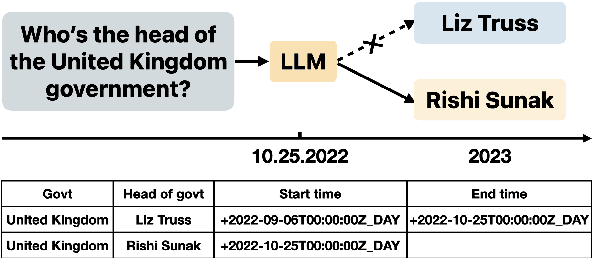

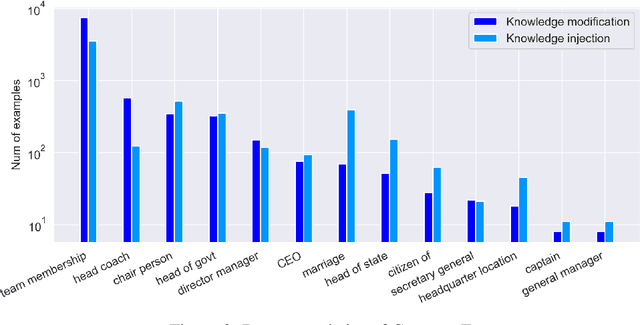
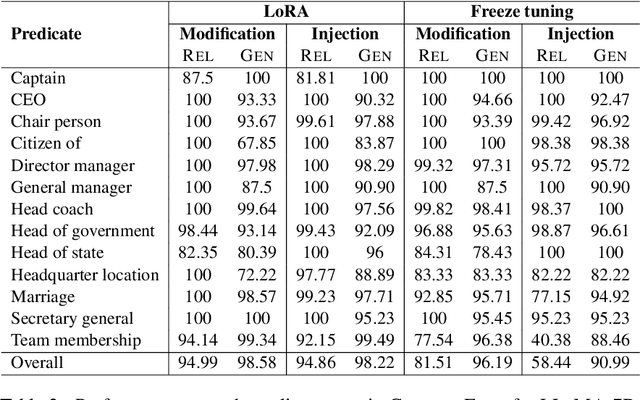
Abstract:Large Language Models (LLMs) have demonstrated impressive capability in different tasks and are bringing transformative changes to many domains. However, keeping the knowledge in LLMs up-to-date remains a challenge once pretraining is complete. It is thus essential to design effective methods to both update obsolete knowledge and induce new knowledge into LLMs. Existing locate-and-edit knowledge editing (KE) method suffers from two limitations. First, the post-edit LLMs by such methods generally have poor capability in answering complex queries that require multi-hop reasoning. Second, the long run-time of such locate-and-edit methods to perform knowledge edits make it infeasible for large scale KE in practice. In this paper, we explore Parameter-Efficient Fine-Tuning (PEFT) techniques as an alternative for KE. We curate a more comprehensive temporal KE dataset with both knowledge update and knowledge injection examples for KE performance benchmarking. We further probe the effect of fine-tuning on a range of layers in an LLM for the multi-hop QA task. We find that PEFT performs better than locate-and-edit techniques for time-sensitive knowledge edits.
Entity Disambiguation via Fusion Entity Decoding
Apr 02, 2024Abstract:Entity disambiguation (ED), which links the mentions of ambiguous entities to their referent entities in a knowledge base, serves as a core component in entity linking (EL). Existing generative approaches demonstrate improved accuracy compared to classification approaches under the standardized ZELDA benchmark. Nevertheless, generative approaches suffer from the need for large-scale pre-training and inefficient generation. Most importantly, entity descriptions, which could contain crucial information to distinguish similar entities from each other, are often overlooked. We propose an encoder-decoder model to disambiguate entities with more detailed entity descriptions. Given text and candidate entities, the encoder learns interactions between the text and each candidate entity, producing representations for each entity candidate. The decoder then fuses the representations of entity candidates together and selects the correct entity. Our experiments, conducted on various entity disambiguation benchmarks, demonstrate the strong and robust performance of this model, particularly +1.5% in the ZELDA benchmark compared with GENRE. Furthermore, we integrate this approach into the retrieval/reader framework and observe +1.5% improvements in end-to-end entity linking in the GERBIL benchmark compared with EntQA.
Construction of Paired Knowledge Graph-Text Datasets Informed by Cyclic Evaluation
Sep 20, 2023



Abstract:Datasets that pair Knowledge Graphs (KG) and text together (KG-T) can be used to train forward and reverse neural models that generate text from KG and vice versa. However models trained on datasets where KG and text pairs are not equivalent can suffer from more hallucination and poorer recall. In this paper, we verify this empirically by generating datasets with different levels of noise and find that noisier datasets do indeed lead to more hallucination. We argue that the ability of forward and reverse models trained on a dataset to cyclically regenerate source KG or text is a proxy for the equivalence between the KG and the text in the dataset. Using cyclic evaluation we find that manually created WebNLG is much better than automatically created TeKGen and T-REx. Guided by these observations, we construct a new, improved dataset called LAGRANGE using heuristics meant to improve equivalence between KG and text and show the impact of each of the heuristics on cyclic evaluation. We also construct two synthetic datasets using large language models (LLMs), and observe that these are conducive to models that perform significantly well on cyclic generation of text, but less so on cyclic generation of KGs, probably because of a lack of a consistent underlying ontology.
Growing and Serving Large Open-domain Knowledge Graphs
May 16, 2023Abstract:Applications of large open-domain knowledge graphs (KGs) to real-world problems pose many unique challenges. In this paper, we present extensions to Saga our platform for continuous construction and serving of knowledge at scale. In particular, we describe a pipeline for training knowledge graph embeddings that powers key capabilities such as fact ranking, fact verification, a related entities service, and support for entity linking. We then describe how our platform, including graph embeddings, can be leveraged to create a Semantic Annotation service that links unstructured Web documents to entities in our KG. Semantic annotation of the Web effectively expands our knowledge graph with edges to open-domain Web content which can be used in various search and ranking problems. Finally, we leverage annotated Web documents to drive Open-domain Knowledge Extraction. This targeted extraction framework identifies important coverage issues in the KG, then finds relevant data sources for target entities on the Web and extracts missing information to enrich the KG. Finally, we describe adaptations to our knowledge platform needed to construct and serve private personal knowledge on-device. This includes private incremental KG construction, cross-device knowledge sync, and global knowledge enrichment.
High-Throughput Vector Similarity Search in Knowledge Graphs
Apr 04, 2023



Abstract:There is an increasing adoption of machine learning for encoding data into vectors to serve online recommendation and search use cases. As a result, recent data management systems propose augmenting query processing with online vector similarity search. In this work, we explore vector similarity search in the context of Knowledge Graphs (KGs). Motivated by the tasks of finding related KG queries and entities for past KG query workloads, we focus on hybrid vector similarity search (hybrid queries for short) where part of the query corresponds to vector similarity search and part of the query corresponds to predicates over relational attributes associated with the underlying data vectors. For example, given past KG queries for a song entity, we want to construct new queries for new song entities whose vector representations are close to the vector representation of the entity in the past KG query. But entities in a KG also have non-vector attributes such as a song associated with an artist, a genre, and a release date. Therefore, suggested entities must also satisfy query predicates over non-vector attributes beyond a vector-based similarity predicate. While these tasks are central to KGs, our contributions are generally applicable to hybrid queries. In contrast to prior works that optimize online queries, we focus on enabling efficient batch processing of past hybrid query workloads. We present our system, HQI, for high-throughput batch processing of hybrid queries. We introduce a workload-aware vector data partitioning scheme to tailor the vector index layout to the given workload and describe a multi-query optimization technique to reduce the overhead of vector similarity computations. We evaluate our methods on industrial workloads and demonstrate that HQI yields a 31x improvement in throughput for finding related KG queries compared to existing hybrid query processing approaches.
Hamiltonian Adaptive Importance Sampling
Sep 27, 2022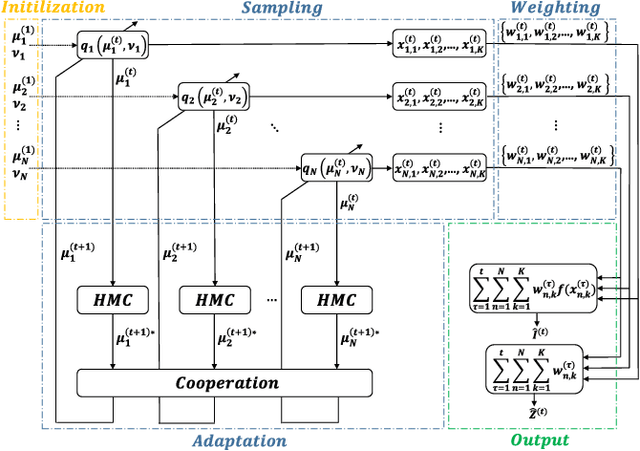
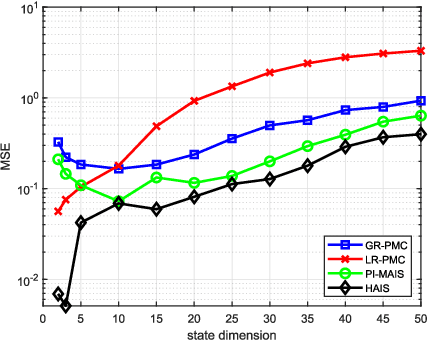

Abstract:Importance sampling (IS) is a powerful Monte Carlo (MC) methodology for approximating integrals, for instance in the context of Bayesian inference. In IS, the samples are simulated from the so-called proposal distribution, and the choice of this proposal is key for achieving a high performance. In adaptive IS (AIS) methods, a set of proposals is iteratively improved. AIS is a relevant and timely methodology although many limitations remain yet to be overcome, e.g., the curse of dimensionality in high-dimensional and multi-modal problems. Moreover, the Hamiltonian Monte Carlo (HMC) algorithm has become increasingly popular in machine learning and statistics. HMC has several appealing features such as its exploratory behavior, especially in high-dimensional targets, when other methods suffer. In this paper, we introduce the novel Hamiltonian adaptive importance sampling (HAIS) method. HAIS implements a two-step adaptive process with parallel HMC chains that cooperate at each iteration. The proposed HAIS efficiently adapts a population of proposals, extracting the advantages of HMC. HAIS can be understood as a particular instance of the generic layered AIS family with an additional resampling step. HAIS achieves a significant performance improvement in high-dimensional problems w.r.t. state-of-the-art algorithms. We discuss the statistical properties of HAIS and show its high performance in two challenging examples.
Adaptive Neuro Fuzzy Networks based on Quantum Subtractive Clustering
Jan 26, 2021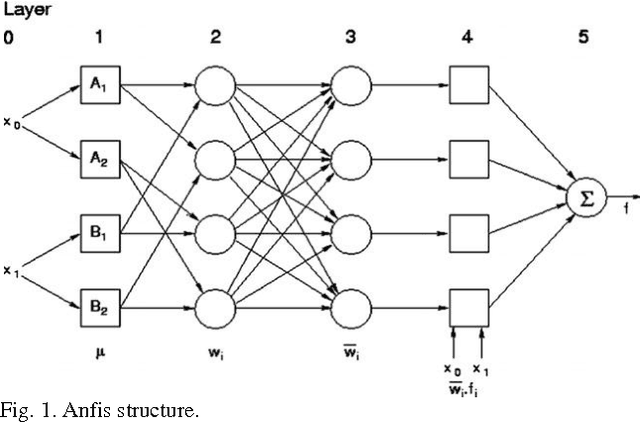
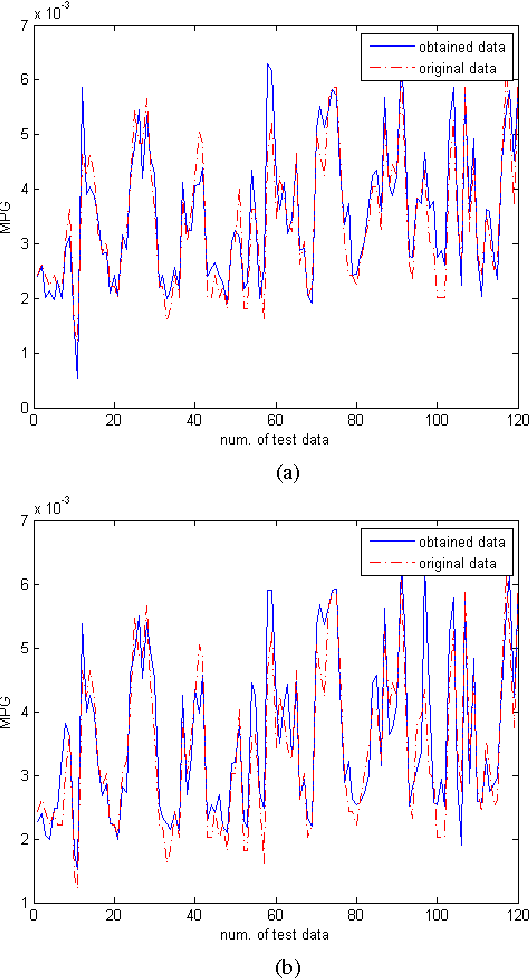
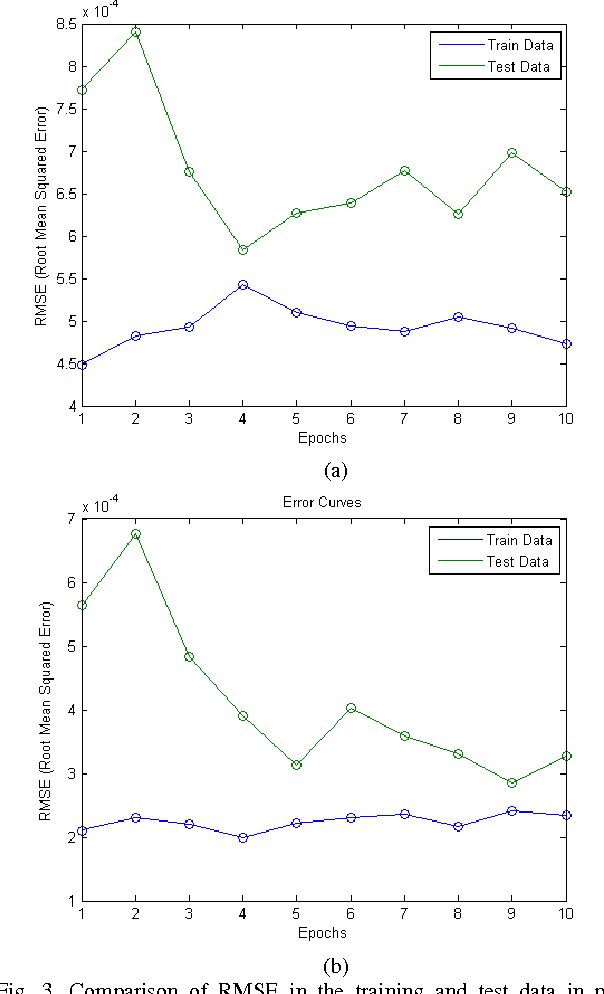
Abstract:Data mining techniques can be used to discover useful patterns by exploring and analyzing data and it's feasible to synergitically combine machine learning tools to discover fuzzy classification rules.In this paper, an adaptive Neuro fuzzy network with TSK fuzzy type and an improved quantum subtractive clustering has been developed. Quantum clustering (QC) is an intuition from quantum mechanics which uses Schrodinger potential and time-consuming gradient descent method. The principle advantage and shortcoming of QC is analyzed and based on its shortcomings, an improved algorithm through a subtractive clustering method is proposed. Cluster centers represent a general model with essential characteristics of data which can be use as premise part of fuzzy rules.The experimental results revealed that proposed Anfis based on quantum subtractive clustering yielded good approximation and generalization capabilities and impressive decrease in the number of fuzzy rules and network output accuracy in comparison with traditional methods.
 Add to Chrome
Add to Chrome Add to Firefox
Add to Firefox Add to Edge
Add to Edge